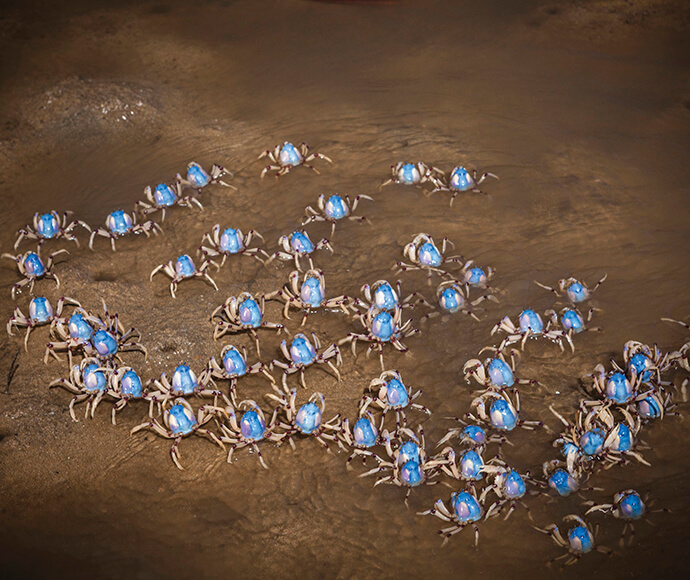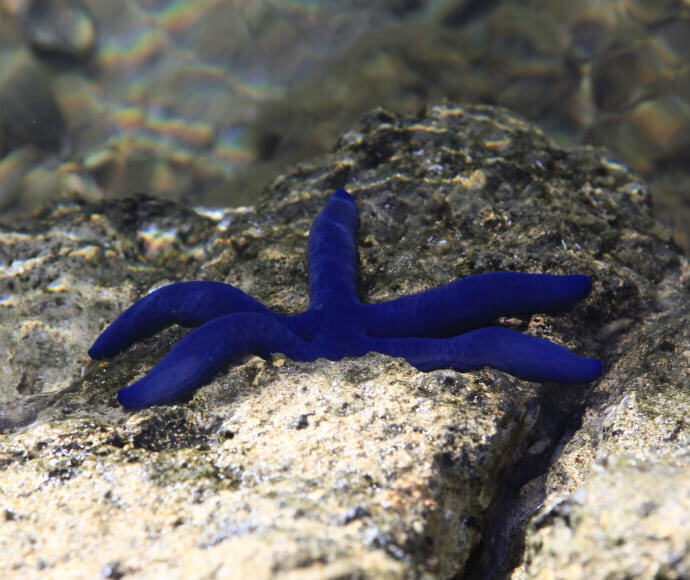Invertebrate animals perform important ecological functions in healthy estuaries – for example, they clean sediments, filter water and recycle detritus. Estuaries provide shelter and food for young invertebrates such as shellfish and marine worms, which in turn provide food for other animals, including humans.
Many marine invertebrates such as oysters and hermit crabs are useful ‘environmental indicators’. This means the health of these animals can tell us whether the surrounding environment is in good or poor condition.
Understanding this diverse group of animals and their habits helps us better protect and manage the estuarine habitats they live in.
Shellfish
Shellfish is a broad term used to describe crustaceans and molluscs. Shellfish play an important role in estuarine food webs.
They are also important in recreational and commercial fishing. Under the Fisheries Management Act 1994 and the Fisheries Management (General) Regulation 2010, the definition of fish includes shellfish and other invertebrates such as worms, sponges, corals, aquatic insects and sea urchins, and sharks and rays.
The responsibility for threatened species and their management is shared between the NSW Department of Primary Industries and Regional Development and the Department of Climate Change, Energy, the Environment and Water under the Biodiversity Conservation Act 2016.
Prawns
Prawns are a main source of food for fish that live in estuaries. Prawns also form a significant component of the commercial fishing industry and are a favoured species in recreational fishing. In New South Wales, the main species of prawn that rely on NSW estuaries to complete their lifecycles are the school prawn, eastern king prawn and greasyback prawn.
Crabs
Crabs live in the mud and sandflats in estuaries, in mangroves and on rocky break walls. Crabs commonly found in NSW estuaries include semaphore, mud, soldier, blue swimmer and hermit crabs. Most crabs need saltwater to survive, which limits their distribution upstream.
Oysters, cockles and mussels
Oysters, cockles and mussels are bivalve filter feeders and help maintain water quality in estuaries. They are not very mobile – some settle on surfaces and remain there for most of their lives and others partially bury in soft sediment and only move with large waves and strong currents.
Oysters grow in large clusters and form complex reefs which provide habitat for many other estuarine species while filtering the water that passes over them. Global efforts are being made to create, maintain and protect oyster reefs due to their ecological value. These shellfish form a large part of the commercial fishing industry in New South Wales.
There are 3 types of oysters in New South Wales:
- the endemic Sydney rock oysters, which are commercially cultivated in sheltered estuaries such as Wallis Lake and the Clyde River
- the introduced Pacific oysters, which are found in the Hastings River and all estuaries to the south
- the native flat oyster, which occurs in sheltered waters of the south coast.
For more information see the oysters webpage on the NSW Department of Primary Industries and Regional Development website.
Cockles are efficient filter feeders, filtering up to 1.5 litres of water per hour! Like many other filter feeders, cockles can retain contaminants dissolved in the water as they feed. Two types of cockles are found in NSW estuaries:
- the Sydney cockle, which lives in seagrass beds and mud flats
- the sand cockle, which is found in tidal flats and seagrass beds in estuary mouths.
Mussels grow in large clusters on hard natural surfaces or artificial structures like pylons and jetties. They often occur in clumps in shallow margins around estuaries after wind, waves or boat wash causes them to come loose from where they were attached.
Two main species of mussel live in NSW estuaries:
- the blue mussel, which often attaches to rocks and structures such as pylons and mooring floats at the seaward end of an estuary
- the pygmy mussel, which is found in high numbers on rocks and mangrove roots in the upper parts of estuaries.
Eight species of freshwater mussels live in coastal streams in New South Wales.
Cephalopods
Squid, cuttlefish and octopus are all cephalopods; that is, they are types of molluscs that have arms attached directly to their heads.
These animals are common in New South Wales and live anywhere from estuaries to shallow coastal waters and deep in the ocean.
Squid often occur in large schools or squads between habitats such as seagrass, macroalgae beds, and bare sandbanks, whereas octopus and cuttlefish are more solitary.
Cephalopods all have the ability to rapidly change colour to avoid predators, surprise prey and attract potential mates.
A huge diversity of cephalopods are found in our estuaries, from the tiny, 25-millimetre-long pygmy squid to the giant maori octopus with arms that can reach a span of 3 metres, and oddities such as the bioluminescent dumpling squid and the highly toxic blue-ringed octopus.
Of these, 4 species of squid are popular in recreational and commercial fishing, and these 4 species can inhabit estuaries at some stage of their lifecycle. These are the:
- mitre squid
- southern calamari
- northern calamari
- arrow squid.
Other invertebrates
Many other invertebrates live in estuaries and provide various functions to the estuarine community. For example:
- Along with zooplankton, invertebrates provide prey for larger estuarine species.
- Polychaete worms recycle detritus in and on estuarine sediments.
- Burrowing by worms, molluscs and small shrimp mix sediments and increase oxygen in the bottom substrate.
- Hard and soft corals feed on tiny plankton and provide habitat for many estuarine species.
- Jellyfish can be super abundant in estuaries at times and are major consumers of plankton.
- Starfish can be major predators of molluscs.
- Sea urchins are important algal grazers and sediment ‘cleaners’.
Threats
Invertebrate animals can be impacted by:
- habitat degradation and loss, such as those of prawns and marine worms, which are found in greater numbers in vegetated habitats compared to bare habitats, so when seagrass is lost from an estuary the number of prawns will reduce
- salinity – for example, oysters have an upper and lower salinity tolerance outside of which they can die if conditions do not return to within normal range
- accumulation of fine sediment, contaminants and pollutants, which can have long-term harmful effects on filter feeders such as oysters
- increased sedimentation and rapid changes in water quality from intensification of landuse within a catchment, which can affect the many invertebrates that live on the seabed and are stationary or slow moving
- overfishing, which is a potential threat for shellfish as it is for all species collected for recreational or commercial purposes
- collection of species, such as estuarine yabbies and worms for use as bait
- sea level rise, ocean acidification, changes in patterns and timings of freshwater runoff and increased water temperature in response to climate change.

